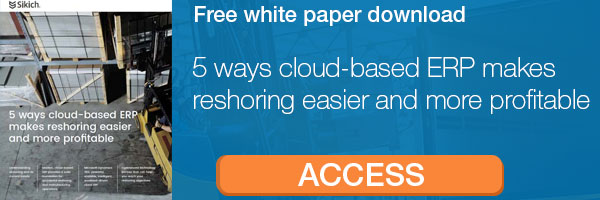When manufacturers think about reshoring operations to North America from an offshore location in another region, business management technology may not always be treated with the priority it deserves. In addition, some manufacturers do not give enough strategic consideration to reshoring and its opportunities for creating a leaner, more customer-centric, more innovative business. As a consequence, companies may replicate the technical environment, workflows, and processes of the offshore operation in their reshoring initiative, including inefficiencies and bottlenecks.
Avoiding high technology costs and process inefficiencies in reshoring
One outcome of poor reshoring planning is high spending on software solutions and hardware systems, with uncertain results. Companies implement complex, expensive ERP and other systems at the same time as reshoring is underway, bringing disruption to an already challenging undertaking. Traditional ERP deployments that are concurrent with reshoring projects have a high likelihood of cost overruns or meager returns in value.
In another common scenario, reshoring manufacturers make do with disparate systems that serve distinct lines of business—manufacturing, finance, warehouse management, and so forth. Costs then increase for several reasons—employees spend time retrieving information from several software tools, or they are distracting IT with requests for assistance. Business groups like engineers or the demand planning team are not as effective working in silos as when they connect with the entire organization and its resources. Processes may not unroll smoothly but instead, suffer from gaps and unproductive time when they can’t sync across the business areas.
Manufacturing anywhere with the cloud
For reshoring manufacturers, a powerful ERP system that enables them to take control of the many moving parts of their operation and optimize processes is the better way to go. But an ERP implementation needs to be non-disruptive, cost-efficient, fast, and likely to meet with rapid adoption by users.
That’s when cloud-based ERP offers the best advantages to reshoring companies. For one thing, you don’t need to worry about moving or building a data center and its supporting infrastructure. You can focus on the business enablement the ERP solution needs to provide. And, if ERP is in the cloud, it can be accessed by users in the offshore as well as the reshore location just as easily. Your transition can begin and end on the same technology platform.
Modern ERP has come a long way even since TechTarget presciently recommended in 2013 that ERP should be one of the computing workloads that can be greatly effective in the cloud. At the time, cloud ERP was often confused with hosted ERP, which still requires client software instead of a simple browser. Since then, true cloud-based ERP has been more widely implemented and demonstrated its value.
In addition, the cloud has freed ERP from the confines of the traditional, all-in-one systems that companies were used to and moved it toward a more flexible, workload-based structure.
Manageable workloads and continuous improvement
In cloud technology, workloads were always an important concept and the most practical way to think about moving tasks and applications from on-premise environments into the cloud. The workload concept applied to cloud ERP means you don’t have to implement all possible capabilities for all users and lines of business at the same time, the way it happens in old-school ERP deployments. Instead, you handle one workload at a time, going at your own pace. Testing and learning from the early stages of the implementation can make successive phases more efficient and predictable.
For reshoring manufacturers, workload-based cloud ERP is also the most risk-controlled path toward gaining advanced business management capabilities. At every step, you can verify your assumptions, fine-tune processes, and closely assess outcomes.
Treat cloud ERP reshoring as an essential condition for the process
With Microsoft Dynamics 365, Microsoft brought advanced ERP and CRM functionality to the Azure cloud in a modular approach that enables manufacturers to follow their priorities. In addition to the manufacturing and other functionality known from the on-premise Microsoft Dynamics ERP systems, companies can access the business analytics and intelligence resources that are available on Azure. A widening subset of the Microsoft partner network is creating cloud-native applications or porting existing solutions to help manufacturers meet remaining functionality gaps.
We recommend separating even an efficient, smooth cloud ERP implementation from your reshoring activities. Get ERP in place, test it, and fine-tune it to your business requirements as one of the fundamentals before you actually begin moving processes to the reshore site. You may also want to invite your key customers and trading partners to take advantage of the self-service and collaborative capabilities you can offer them in the cloud. If they become beneficiaries of cloud ERP, you may produce the reshoring outcomes you want even faster and easier.
Sikich manufacturing and technology expertise can help you perform a successful reshoring initiative and increase the competitive standing and long-term viability of your business. Get started today.
- Read our other blog posts in this cloud ERP reshoring series.
- Contact us about how we can help ease your reshoring transition.






